Facility Design: Simulation Methodology for Facility Design
Discrete simulation allows the design teams to see every meaningful detail about equipment and materials flowing through the process.
Designing a new biological facility or planning the expansion of an existing one requires evaluation of several parameters related to product characteristics, equipment capability, and facility capacity. Decisions made at the design stages are critical to the validation plan and the ongoing operation if it is a commercial facility. Whether the facility will provide the needed future capacity is one of the critical questions requiring a credible answer. This article describes a methodology that uses currently available simulation software as a capacity planning and design tool. The PC-based simulation software described has been available for over 10 years and employees can be trained to use and develop these models. Internal and external engineering teams, operations managers, and validation and process excellence specialists have a stake in a new design, and provide inputs that are important at design stages. This is an example of a project involving all the disciplines in which alternative designs for a sterile filling suite included multiple filling equipment options, robotic cart versus fixed conveyor systems, and different lyophilization equipment (lyos). To illustrate the methodology, a model of a filling operation for a mix of liquid and lyophilized products follows. It includes formulation, filling, lyophilization, and capping in a new commercial sterile facility to meet requirements with uncertainties that are common in forecasting new products. It incorporates examples of using a model to answer "what-if" questions about design parameters and forecast scenarios.
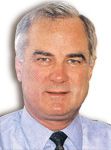
Jim Curry
While this is an example of one portion of the biological supply chain, this approach also applies to bulk production and packaging operations. In addition to design of a commercial operation, it also can be applied to scale up, tech transfer, and validation plan testing.
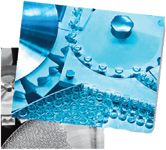
OBJECTIVES AND SCOPE OF PROJECT
The objectives of this project were to finalize the design and select equipment for a commercial facility, given forecast projections for a new product, known requirements of an existing product, and the addition of some derivative products. The facility was expected to be constructed in phases, so phasing of equipment installation and staffing ramp-up once in operation were required.

Quick Recap
The scope of the process to be modeled included:
- Material flow through the following operations: formulation, filling lines; transport either by robotic cart or conveyor; loading the lyos; lyophilization process (freeze drying); unloading the lyos; and capping lines. For the cart option, loading and unloading are done shelf-by-shelf; therefore, accumulation tables are also needed to buffer the filling and capping lines. The conveyor option is a more continuous process and does not require the buffers for shelves.
- Cleaning and other changeover requirements between batches of material included a variety of processes including: manual cleans, clean-in-place (CIP) systems, steam-in-place (SIP) systems, vapor phase hydrogen peroxide (VHP) decontamination, glove integrity tests, and physical equipment changeovers between products and sizes. These applied to both the fixed equipment and portable vessels used in the process.
- Staffing with appropriately skilled personnel was required for cleaning and processing operations. The shift schedules for the various crews and skills in the parameters had to be evaluated.
- Activities and issues considered to be unconstrained and therefore out of scope included: availability of incoming materials and sampling; cold storage room, inspection, and packaging of completed materials; tray storage after lyophilization; and availability of portable vessels and rapid transfer port (RTP) canisters.
MODEL SETUP
Setting up a model requires basic data about the product and process characteristics. A unique characteristic of these simulators is their capability to use spreadsheets as an input or output mechanism, so that changes in parameters can be made in a familiar format. Figure 1 shows a high-level model construction fed by the process times and rules specified in the spreadsheets.
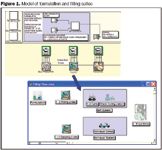
Figure 1
There were multiple product types planned for the facility. Liquid products in either vials or syringes do not get processed through the lyos; they are formulated, filled, and then capped. An assumption was made that if lyophilized syringes were filled, there would be a separate loading system to the lyos. Lyophilized products in either vials or syringes go through all processes.
Some of the parameters to describe the process included:
- Formulation times and rules: SIP is done before processing starts and formulation tanks are cleaned by the CIP system after completion. Formulation of the next batch may begin while the cleaning and changeover in filling is in progress. Maximum hold times were also a constraint in scheduling when to start formulation. Liquids batches had to be completed filling and capping within 24 hours of formulation completion. Lyophilized batches had to be in the lyos within 32 hours of formulation completion.
- Filling and capping: Times were specified for VHP decontamination before a batch, and manual cleaning after and changeover times for different products. VHP decontamination took approximately eight hours, and had to be done within 24 hours prior to starting. Filling of a liquids batch could also not start until both the filling and capping lines were completed cleaning and changeover. Filling startup times included line purging, weight checks, bringing up to temperature, and also had some estimated yield loss. As shown in Figure 1, the number of both filling and capping lines were variable, from 1 to 3 each. Other key variables were the lines speeds (vials or syringes per minute) that the lines were run at.
- Lyo systems: The number of systems was variable (4–6), as was the freeze dry time (3–5 days), size of shelves per lyo (33–58 square meters), and number of shelves. For example, capacity of a 40 square meter lyo was 58,000 vials, 16 shelves with 3,000 vials per shelf, or 1,450 vials per square meter. Similar decontamination rules before and a one-day cleaning process after applied to the lyos.
- Carts and conveyor systems: For the robotic cart system, the number of carts, number of CIP systems, the track configuration, and the locations of the filling and capping lines were all parameters to be changed and tested. Liquids products were moved from filling to capping, bypassing the lyos. The track or conveyor layout dictated which lyos and sequence possible could be practical for loading and unloading. The conveyors were fixed and carts could not cross each other on a single track. Thus the flexibility to designate different sets of filling and capping lines dedicated to specific lyos was included. The filling, loading and unloading, and capping times varied by configuration also, since the distance varied. Therefore, scenarios included defined routings allowed, which defined how many lyos could be loaded or unloaded simultaneously; e.g., with six lyos, 3 & 3 indicates two simultaneously, one from any of the first three and one from any of the second three.
The carts and conveyor had similar cleaning and VHP decontamination rules. Carts used CIP systems, of which one or two were considered, and required decontamination before the next use. The fixed conveyor system had multiple zones possible (up to five considered), and the cleaning and de-contamination had to be done sequentially.
All processing rules and cleaning are dependent on having skilled people available at the times required. Early runs of the model showed a high dependency on crewing because of the asynchronous nature of events occurring. The flexibility to change crew sizes and scheduled days per week, shifts per day, and hours per shift was included.
EVALUATING ALTERNATIVES
The value add of using simulation becomes apparent when the overall process rules and variability that exists in the actual operation are added to the problem definition. The asynchronous nature of a complex system like this is impossible to "get your head around" all of the parameters without it.
Semiannual planned shutdown for a facility of this type was 5 weeks, so 21 weeks were available for processing every 6 months. The time phasing of various facility configurations and staffing levels was evaluated based on that.
Once a baseline scenario for a volume level was run successfully without any variability, probabilistic inputs for most parameters were created from other similar facilities or equipment vendors. Monte carlo simulation runs incorporating these variability inputs were used to establish results with statistical confidence intervals. The lyophilization cycle itself was an exception; time was locked in with one-hour deviation at most. Statistical distributions for deviations were assumed in formulation process times, which included filling and capping line speeds where people are involved. Figure 2 shows two examples of variability in filling and capping line speeds for different products. It was also assumed, based on experience, that changeover and manual cleanings would probably have the most deviation. Unplanned downtime based on time to failure and time to repair was also incorporated on all equipment, and probabilities of absenteeism were estimated for staffing.
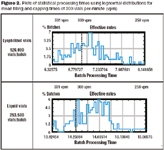
Figure 2
Differences of opinion were voiced among the operations, engineering, R&D, and operations excellence members of the team as to what filling and capping rates should be used for the design. The mean line rates were key drivers in the volume that could be expected from the facility. For example, if the manufacturer's stated maximum line rate is 400 vpm, what mean rate should be used for planning the facility design? The model results became a credible way to judge the reasonableness of the assumptions about the planned line rates.
Before running the model, engineering work had been done on basic configurations and designs using timelines in spreadsheets. These did not include the process variability, staffing, or decontamination and cleaning implications of the operation, but they did rule out certain configurations as unsatisfactory. When model runs were begun, it became obvious that some other alternatives would not work when all the asynchronous events in the process were taken into account.
Over a two-month period, hundreds of simulations were run to test results of various configurations. Table 1 depicts some of the configurations that were evaluated in more detail for both the cart and fixed conveyor configurations, with the key driver parameters.
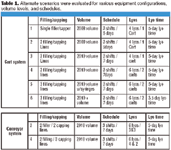
Table 1. Alternate scenarios were evaluated for various equipment configurations, volume levels, and schedules.
Each of these configurations had sets of monte carlo simulations run for them to determine best and worst case results. An example summary for one of the scenarios is shown in Table 2. It shows summarized results for cart scenario 5 shown in Table 1 with types of volume, wait times, and utilization metrics possible.
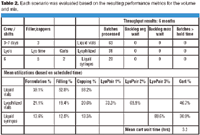
Table 2. Each scenario was evaluated based on the resulting performance metrics for the volume and mix.
In addition to these types of summary metrics, discrete simulation allows the design teams to see every meaningful detail about equipment and materials flowing through the process. For example, Table 2 shows that a batch of material waits an average of 3.2 hours for a cart to be available in this scenario. There are detailed metrics and graphics to help understand the reasons. Figure 3 shows a graphic of utilization of the lines and lyos on a time line over the duration of the simulation run. It is one example of why a cart is not available, that would be included in the summary results.

Figure 3
A similar example of resource utilization for a fixed conveyor configuration is shown in Figure 4. The sequence of preprocessing decontamination steps for each zone is depicted, rather than the cart activity.
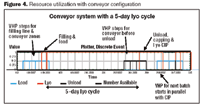
Figure 4
RESULTS FROM SIMULATION
For this project, with the product mix and volumes projected, and for the constraints of the facility design the team was working with, there were several findings that resulted from the modeling that would not have been possible, or would have been unlikely uncovered without it. These included:
- Staffing levels would have to be 24/7 even at lowest anticipated volume levels in order to have skills available to perform all the required operations.
- The cart single track constraint could be a limiting factor even with the 3.5 day lyo time, given the sensitivity that existed with wait times for the carts.
- In the fixed conveyor system configuration, there was less buffer time available to make the required volumes due to the requirement for VHP decontamination of the conveyor zones.
- For the 3 & 3 configuration, the conveyor cleaning time after unloading became a constraint at about 8 hours total time.
- For the 4 & 2 configuration, the time after unloading did not have an effect until 12 hours.
- The variability in times after unloading for manual cleaning and changeover activities could have a significant effect on throughput, and were also managed in an ongoing Six Sigma program.
- Alternative schedules to process batches on regular repetitive cycles should be simulated as the project went forward to attain the level of throughput consistency required.
FUTURE POSSIBILITIES
Given the cost of developing and bringing a new drug to market, and the investment required for manufacturing capacity in the commercial and earlier stages, discrete simulation technology should be considered an essential tool. The examples shown above were meant to demonstrate that the tools are robust enough to handle even the most complex rules we face in designing facilities, processes, and schedules to run an operation. This project used the Extend simulation program from Imagine That, Inc.
Companies use spreadsheets with averages for the processing times involved, and project planning systems with probabilistic ranges of times. Neither of these is as robust as the latest discrete simulation tools. Simulation proves the point very specifically that "idle time can never be made up" when there is a constrained resource in the system. In other words, things do not even out when using average times.
To successfully implement these types of simulation tools requires training programs and commitment. The programs are already being taught in both undergraduate and graduate programs. Therefore, there are engineers and analysts who are well-versed with these tools. A key to success is giving people the time to learn and work with them.
Jim Curry is the CEO of OpStat Group, Inc., Ridgefield, CT, 203.431.3905, jimcurry@OpStat.com
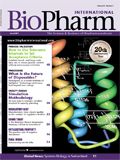
VERAXA and Voyager to Create Combined Business for Advancing Pipeline of Next-Gen Cancer Therapies
April 23rd 2025The proposed business combination would create a publicly traded, clinical-stage biopharmaceutical company that will focus on developing a pipeline of next-generation cancer therapies.
Thermo Fisher Opens Advanced Therapies Collaboration Center in California
April 18th 2025The 6000-square-foot facility will provide cell therapy developers the support they need to transition to CGMP manufacturing, and an expanded footprint of the new center is expected to open in Philadelphia later in 2025.